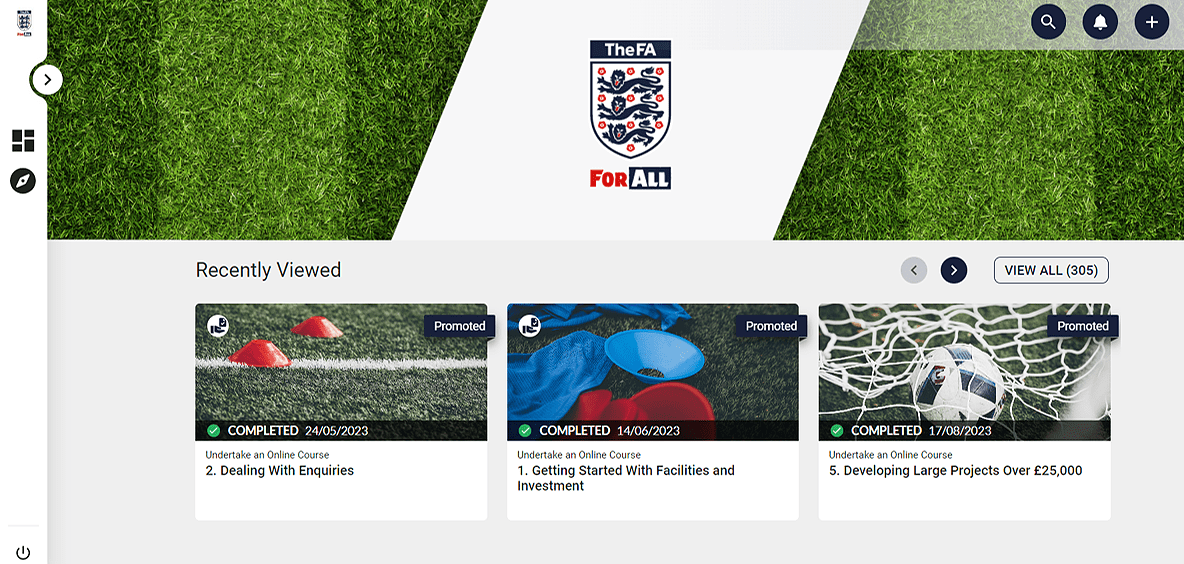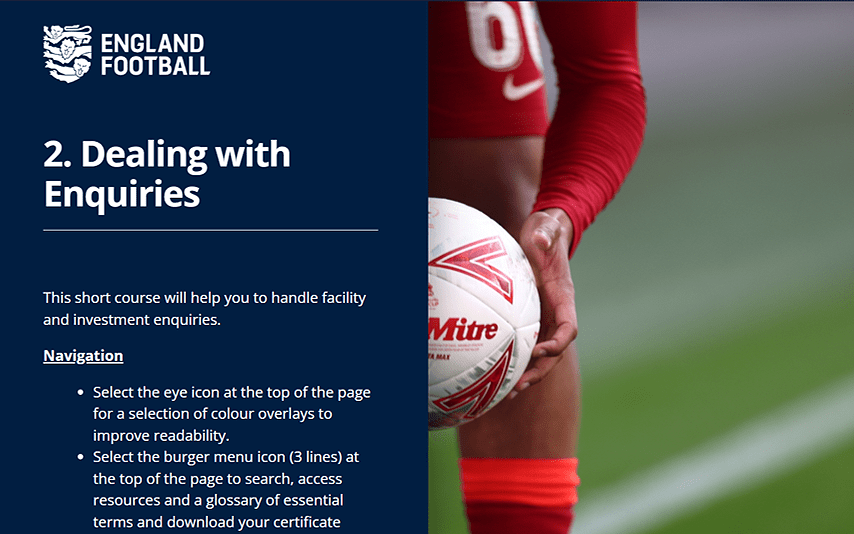
The FA
Transforming The FA's grassroots football facilities with innovative digital learning, resulting in 5,600 quality pitches and a 7-14% increase in female and disabled player participation.
Background
Operating across England, the FA is responsible for promoting and developing every level of the game, from grassroots through to professional. It oversees vastly successful international teams, tournaments such as the Emirates FA Cup and Barclays Women’s Super League, and the world-class facilities of Wembley Stadium and St. George’s Park. Despite its global recognition in these arenas, the FA remains deeply rooted in local communities, channeling £120m (c.$156m) annually into English football.
At the heart of its mission are County FAs – a national network that receives core funding from the FA to develop football at a local level across England. The FA sets and leads the Grassroots Football Strategy to develop the sport throughout England, and County FAs deliver this strategy, along with other strategic objectives relevant to local needs.
Soggy pitches: A barrier to developing young footballers
How do you inspire and provide for the next generation of footballers when their pitches are poor quality? Soggy waterlogged pitches in the autumn-winter months and parched dusty plains in the summer had led to 40,000 matches being cancelled or postponed each year. With two in three FA County pitches nationwide currently rated as ‘poor’, and 14.1 million grassroots players depending on them, it was time to act.
0
matches being cancelled or postponed each year
0.00 million
Grassroots players
Transformation in Grassroots investment
The FA’s 2020-2024 strategy, ‘Time for Change’, aimed to unify all aspects of the game and set six transformative objectives. A crucial goal was to create 5,000 high-quality grass pitches across England by 2024, addressing the grassroots game’s biggest issue of poor-quality pitches. This required a significant personnel increase.
Recognizing this challenge, the FA apportioned central funding secured from the government and partners to fund the team’s expansion from 30 to 53 FTEs.
The learning need
The rapid personnel expansion necessitated a significant increase in training to ensure new officers could quickly learn a complex, evolving knowledge base. The Facilities Team identified the need for a digital learning program as a timely resource for these officers. However, existing training materials needed to be more scalable for a larger team. Recognising this, the FA collaborated with Learning Pool to deliver a transformational project to enhance learning for the influx of new starters.
A commitment to rapid and adaptive learning
To achieve its goals without increasing training costs required some creative thinking. The FA and Learning Pool, therefore, chose to use the FA’s existing e-learning platform, the Training Ground, to host the training material, creating a new, dedicated F&I ‘playlist’.
These bite-sized modules were designed to provide comprehensive training and support to new and existing F&I officers, who often work independently within their County FA structures. Modules were aligned with key officer objectives and included topics such as dealing with facilities enquiries, creating partnerships with local stakeholders, and developing facilities projects for clubs.
L&D program’s key goals
The main strategic goals for the L&D program were to:
- Transform grassroots football facilities by delivering 5,000 quality grass pitches by 2024.
- Boost participation rates to 14% for girls, 7% for women, and 7% for disabled players by improving facility accessibility.
- Support future growth and sustainability, with plans to extend the quality pitch target in the next strategy period.
Additional and related objectives that align with the County FA’s key priorities included:
- Increase speed to competency, with a goal to have all staff fully trained within 6 months.
- Improve County FA staff knowledge and skills.
- Increase ability to meet F&I KPIs.
- Improve resource allocation
Back of the net: Achieving the above goals
With the help of Football Facilities and Investment consultant, Caroline Smith, the new Training Ground content was written and built in-house, using Learning Pool’s Adapt tool – their user-friendly authoring platform that enables users to create responsive and engaging online courses. In the lead up to release, a dedicated working group comprising six experienced Facilities Leads, periodically provided valuable insights to shape the content to cater the specific needs of the new workforce.
Innovative digital learning
The team developed an engaging and user-friendly F&I playlist by creating bespoke content in short, bite-sized modules that take about 5-10 minutes to complete. They incorporated various assessment methods, including scenario assessments and quizzes, to track learning outcomes and reinforce key concepts.
To cater to diverse learning styles, the Training Ground used visual and interactive aids, such as clear signposting to key documents, detailed case studies, embedded links, email templates, reading materials, FAQs, video content, and visual references like maps and pictures. These resources were designed to be easily applied in day-to-day roles.
The first batch course content was launched on the same date as the FA’s annual F&I conference, with further courses released in February 2024 and the final installment to launch in September 2024.
The impact
In March 2024, The Training Academy conducted a listening exercise with Boost’s design input. The aim was to evaluate learners’ thoughts on the course, its impact on their skills and knowledge, and its practical application. The results were resoundingly positive. When asked about the likelihood of recommending the F&I courses to peers, respondents showed strong approval with a Net Promoter Score (NPS) of +61.54. Crucially, the research also proved that F&I staff regularly apply their learnings day-to-day, scoring the frequency on average 6.96/10 (10 being ‘regularly every day’).
This positive sentiment was further corroborated by verbal feedback:
“Really useful content for new starters. A valuable opportunity to learn the context behind F&I before beginning to interact with key partners”
“The diversity in courses helps broaden wider skillsets.”
“The access is easy and the layout is good, so easy to pick up learning for free and digitally.”
Mission accomplished
The implementation of the new training content has brought significant benefits to the FA and achieved all the goals set out:
- Minimal F&I training costs have led to significant savings, optimized resources, and reduced travel and carbon emissions.
- The target of 5,000 quality pitches has been exceeded and now sits at 5,600, enabling the FA to progress towards its long-term goals of expansion.
- Improvements in facilities are already leading to an increase in female and disabled players, which have risen by between 7% and 14% and 7% respectively.
- Supporting future expansion and sustainability through the successful upgrade of the Training Ground, setting the stage for further developments aligned with the FA’s long-term goals
Got a learning problem to solve?
Get in touch to discover how we can help


